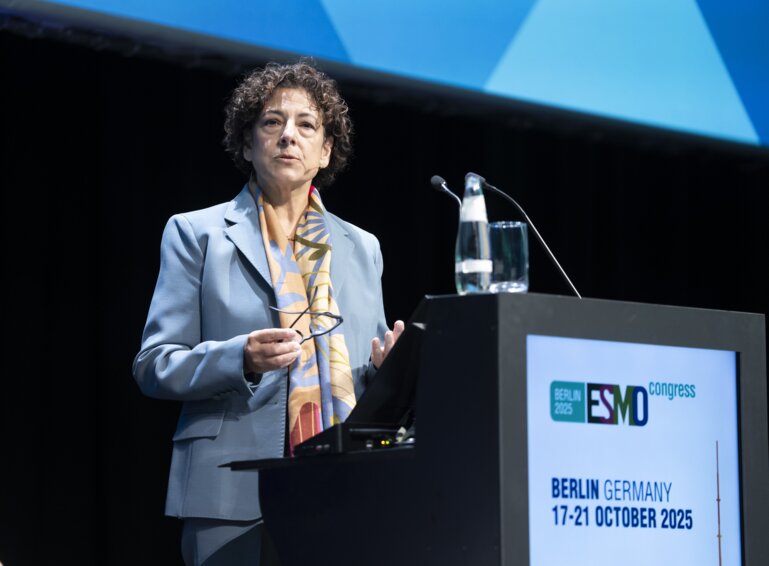Phase I/II trials also show these compounds have more convenient dosing and are well tolerated in both the early and advanced settings
Presented today at the ESMO Congress 2021, initial phase I/II trial data in the post-menopausal ER+/HER2– breast cancer setting report good antiproliferative activity for next-generation oral selective oestrogen receptor degraders, showing promise for a potential addition of these compounds to the current standard endocrine options, especially in resistant disease.
In an interim analysis of the phase II open-label coopERA BC study – involving 83 patients with early breast cancer – the selective oestrogen receptor degrader (SERD), giredestrant, demonstrated superior antiproliferative activity to anastrozole (2-week relative Ki67 reduction [geometric mean] of 80% versus 67%, respectively; p=0.0222) (LBA14). At Week 2, five-times as many tumours exhibited complete cell cycle arrest with giredestrant (25%) compared with anastrozole (5%). Endocrine therapy-related adverse events were less common with giredestrant than with anastrozole (28% versus 38%, respectively).
“The findings from the window-of-opportunity phase of the coopERA BC study regarding early antiproliferative activity are very interesting and suggest better activity of single-agent giredestrant, compared with current standard options in the pre-operative setting. It will be interesting to see the clinical activity of this agent in combination with palbociclib in the neoadjuvant phase of this trial. We will also have to wait to see if similar activity is noted in ongoing trials in the adjuvant setting,” says Dr Luca Malorni from the Hospital of Prato, Italy.
In a second trial, the phase I/II AMEERA-1 study, a subgroup analysis involving 35 patients with metastatic breast cancer, reported that amcenestrant plus palbociclib led to an objective response rate among 34 response-evaluable patients of 32.4%, which was consistent in patients with ESR1-wild-type and ESR1-mutated disease (30.8% and 37.5%, respectively)
“With almost 10 new oral SERDs currently in different stages of clinical development, these results are definitely exciting,” highlights Malorni. “For decades, clinicians have been treating metastatic breast cancer with the only SERD available, fulvestrant. However, poor bioavailability and the need for intramuscular administration have limited its use, particularly in the adjuvant setting. These new compounds provide more convenient dosing and show good activity and tolerability in both the early and advanced settings.”
Toxicity does not appear to be problematic. “Based on the current data, oral SERDs as a class appear to be very well tolerated and do not add to the toxicity of CDK4/6 inhibitors when used in combination,” Malorni thinks. “However, in contrast to tamoxifen and aromatase inhibitors, which have been administered routinely for years in the adjuvant setting, we do not yet have information on the long-term toxicity of SERDs, including fulvestrant. I am hopeful that this data deficit will be provided by ongoing trials.”
According to the expert, these promising findings represent an important advance especially for resistant metastatic breast cancer. “Many of our patients develop endocrine resistance due to the emergence of ESR1 gene mutations,” he says. “The data presented show that oral SERDs maintain high activity even in the presence of these mutations, providing a more active alternative to the current standard endocrine options.” However, Malorni is realistic about the development of resistance. “We expect that oral SERDs will be no exception to the myriad of different cellular and molecular processes leading to endocrine therapy escape and disease progression. But I am confident that our increased understanding of the molecular mechanisms involved should soon lead to the identification of predictive dynamic circulating biomarkers that can be used early after treatment initiation,” he cautions.
To this regard, one potential strategy would be that clinical trial design should be adapted to include early switching of treatment in patients without biomarker response. “This approach may also facilitate the identification of patients with intrinsic resistance and accelerate the discovery of new treatment combinations for them,” he suggests.
There is a long way to go, as these results with oral SERDs are from relatively small cohorts in early-phase trials. “That said, we can probably expect to see the appearance of oral SERDs in clinical practice within the next few years,” concludes Malorni.
Hurvitz S A et al. Neoadjuvant giredestrant (GDC-9545) + palbociclib (palbo) vs anastrozole (A) + palbo in post-menopausal women with oestrogen receptor-positive, HER2-negative, untreated early breast cancer (ER+/HER2– eBC): Interim analysis of the randomised, open-label, phase 2 coopERA BC study. ESMO Congress 2021, LBA14
Mini oral session – Breast cancer, early stage, 20.9.2021, h. 17:58 – 18:03, Channel 1
Chandarlapaty S et al. AMEERA-1: Subgroup analyses of Phase 1/2 study of amcenestrant (SAR439859), an oral selective estrogen receptor (ER) degrader (SERD), with palbociclib in postmenopausal women with ER+/ human epidermal growth factor receptor 2-negative (HER2–) advanced breast cancer (aBC). ESMO Congress 2021, 264P







